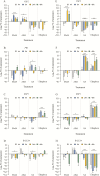Defence signalling marker gene responses to hormonal elicitation differ between roots and shoots
- PMID: 29977487
- PMCID: PMC6007416
- DOI: 10.1093/aobpla/ply031
Defence signalling marker gene responses to hormonal elicitation differ between roots and shoots
Abstract
Phytohormones such as jasmonic acid (JA), salicylic acid (SA), ethylene (ET) and abscisic acid (ABA) play a key role in regulation of plant immune responses to different attackers. Extensive research over recent years has led to the identification of molecular markers for specific hormonal-regulated defence pathways. However, most of our current knowledge on the regulation of plant immunity derives from studies focused on above-ground organs, mainly on the model plant Arabidopsis thaliana. Therefore, it is unclear whether the paradigms based on experiments on above-ground organs are entirely transferable to roots. Here, we used the non-model plant Brassica rapa to study the regulation dynamics of hormonal-related marker genes in both roots and shoots. These markers were identified in Arabidopsis shoots after elicitation of the JA-, SA-, ET- or ABA-signalling pathways, and are commonly used to study induced responses. We assessed whether the regulation of those genes by hormonal elicitation differs between roots and shoots. To discern whether the differences in marker gene expression between roots and shoots are related to differences in hormone production or to differential responsiveness, we also measured actual hormone content in the treated tissue after elicitation. Our results show that some of the widely used markers did not show specific responsiveness to single hormone applications in B. rapa. We further found that hormonal elicitation led to different response patterns of the molecular markers in shoots and roots. Our results suggest that the regulation of some hormonal-related marker genes in B. rapa is organ specific and differs from the Arabidopsis-derived paradigms.
Keywords: Brassica; hormonal signalling; marker genes; phytohormones; plant defences.
Figures



Similar articles
-
Plant Immunity Is Compartmentalized and Specialized in Roots.Front Plant Sci. 2018 Nov 28;9:1692. doi: 10.3389/fpls.2018.01692. eCollection 2018. Front Plant Sci. 2018. PMID: 30546372 Free PMC article. Review.
-
Antagonism between salicylic and abscisic acid reflects early host-pathogen conflict and moulds plant defence responses.Plant J. 2009 Aug;59(3):375-86. doi: 10.1111/j.1365-313X.2009.03875.x. Epub 2009 Apr 24. Plant J. 2009. PMID: 19392690
-
Expression profiling of marker genes responsive to the defence-associated phytohormones salicylic acid, jasmonic acid and ethylene in Brachypodium distachyon.BMC Plant Biol. 2016 Mar 2;16:59. doi: 10.1186/s12870-016-0749-9. BMC Plant Biol. 2016. PMID: 26935959 Free PMC article.
-
Development of marker genes for jasmonic acid signaling in shoots and roots of wheat.Plant Signal Behav. 2016 May 3;11(5):e1176654. doi: 10.1080/15592324.2016.1176654. Plant Signal Behav. 2016. PMID: 27115051 Free PMC article.
-
Signaling Crosstalk between Salicylic Acid and Ethylene/Jasmonate in Plant Defense: Do We Understand What They Are Whispering?Int J Mol Sci. 2019 Feb 4;20(3):671. doi: 10.3390/ijms20030671. Int J Mol Sci. 2019. PMID: 30720746 Free PMC article. Review.
Cited by
-
A Truncated Singleton NLR Causes Hybrid Necrosis in Arabidopsis thaliana.Mol Biol Evol. 2021 Jan 23;38(2):557-574. doi: 10.1093/molbev/msaa245. Mol Biol Evol. 2021. PMID: 32966577 Free PMC article.
-
Deleterious phenotypes in wild Arabidopsis arenosa populations are common and linked to runs of homozygosity.G3 (Bethesda). 2024 Mar 6;14(3):jkad290. doi: 10.1093/g3journal/jkad290. G3 (Bethesda). 2024. PMID: 38124484 Free PMC article.
-
Effects of Prohydrojasmon on the Number of Infesting Herbivores and Biomass of Field-Grown Japanese Radish Plants.Front Plant Sci. 2021 Aug 12;12:695701. doi: 10.3389/fpls.2021.695701. eCollection 2021. Front Plant Sci. 2021. PMID: 34475878 Free PMC article.
-
Plant Immunity Is Compartmentalized and Specialized in Roots.Front Plant Sci. 2018 Nov 28;9:1692. doi: 10.3389/fpls.2018.01692. eCollection 2018. Front Plant Sci. 2018. PMID: 30546372 Free PMC article. Review.
-
Unearthing the Plant Growth-Promoting Traits of Bacillus megaterium RmBm31, an Endophytic Bacterium Isolated From Root Nodules of Retama monosperma.Front Plant Sci. 2020 Feb 27;11:124. doi: 10.3389/fpls.2020.00124. eCollection 2020. Front Plant Sci. 2020. PMID: 32174934 Free PMC article.
References
-
- Abe H, Narusaka Y, Sasaki I, Hatakeyama K, Shin-I S, Narusaka M, Fukami-Kobayashi K, Matsumoto S, Kobayashi M. 2011. Development of full-length cDNAs from Chinese cabbage (Brassica rapa subsp. pekinensis) and identification of marker genes for defence response. DNA Research 18:277–289. - PMC - PubMed
-
- Anderson JP, Badruzsaufari E, Schenk PM, Manners JM, Desmond OJ, Ehlert C, Maclean DJ, Ebert PR, Kazan K. 2004. Antagonistic interaction between abscisic acid and jasmonate-ethylene signaling pathways modulates defense gene expression and disease resistance in Arabidopsis. The Plant Cell 16:3460–3479. - PMC - PubMed
-
- Berrocal‐Lobo M, Molina A, Solano R. 2002. Constitutive expression of ETHYLENE‐RESPONSE‐FACTOR1 in Arabidopsis confers resistance to several necrotrophic fungi. The Plant Journal 29:23–32. - PubMed
LinkOut - more resources
Full Text Sources
Other Literature Sources

